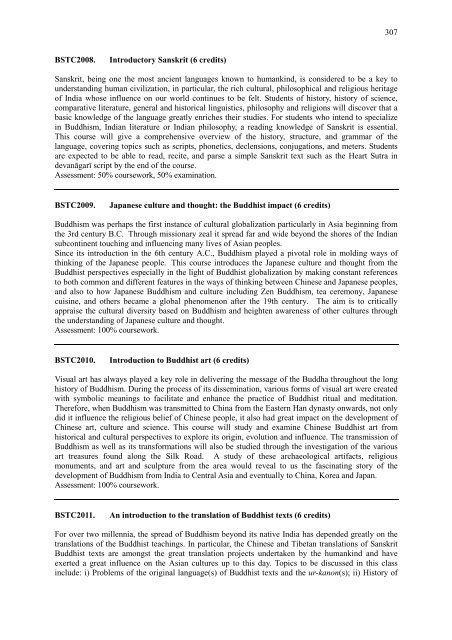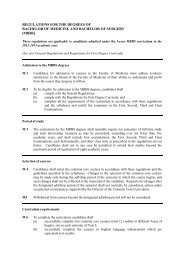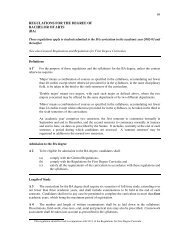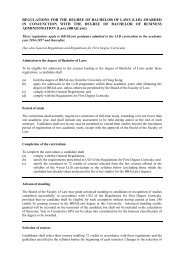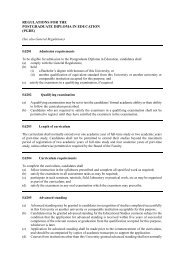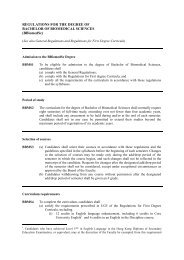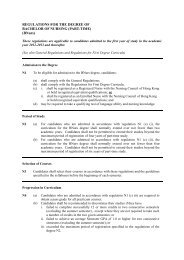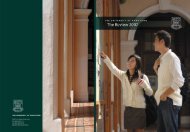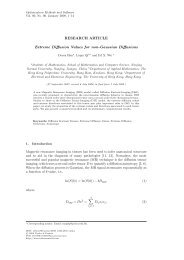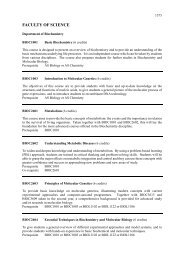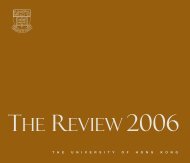(BA) (4-year-programme) - The University of Hong Kong
(BA) (4-year-programme) - The University of Hong Kong
(BA) (4-year-programme) - The University of Hong Kong
You also want an ePaper? Increase the reach of your titles
YUMPU automatically turns print PDFs into web optimized ePapers that Google loves.
307BSTC2008.Introductory Sanskrit (6 credits)Sanskrit, being one the most ancient languages known to humankind, is considered to be a key tounderstanding human civilization, in particular, the rich cultural, philosophical and religious heritage<strong>of</strong> India whose influence on our world continues to be felt. Students <strong>of</strong> history, history <strong>of</strong> science,comparative literature, general and historical linguistics, philosophy and religions will discover that abasic knowledge <strong>of</strong> the language greatly enriches their studies. For students who intend to specializein Buddhism, Indian literature or Indian philosophy, a reading knowledge <strong>of</strong> Sanskrit is essential.This course will give a comprehensive overview <strong>of</strong> the history, structure, and grammar <strong>of</strong> thelanguage, covering topics such as scripts, phonetics, declensions, conjugations, and meters. Studentsare expected to be able to read, recite, and parse a simple Sanskrit text such as the Heart Sutra indevanāgarī script by the end <strong>of</strong> the course.Assessment: 50% coursework, 50% examination.BSTC2009.Japanese culture and thought: the Buddhist impact (6 credits)Buddhism was perhaps the first instance <strong>of</strong> cultural globalization particularly in Asia beginning fromthe 3rd century B.C. Through missionary zeal it spread far and wide beyond the shores <strong>of</strong> the Indiansubcontinent touching and influencing many lives <strong>of</strong> Asian peoples.Since its introduction in the 6th century A.C., Buddhism played a pivotal role in molding ways <strong>of</strong>thinking <strong>of</strong> the Japanese people. This course introduces the Japanese culture and thought from theBuddhist perspectives especially in the light <strong>of</strong> Buddhist globalization by making constant referencesto both common and different features in the ways <strong>of</strong> thinking between Chinese and Japanese peoples,and also to how Japanese Buddhism and culture including Zen Buddhism, tea ceremony, Japanesecuisine, and others became a global phenomenon after the 19th century. <strong>The</strong> aim is to criticallyappraise the cultural diversity based on Buddhism and heighten awareness <strong>of</strong> other cultures throughthe understanding <strong>of</strong> Japanese culture and thought.Assessment: 100% coursework.BSTC2010.Introduction to Buddhist art (6 credits)Visual art has always played a key role in delivering the message <strong>of</strong> the Buddha throughout the longhistory <strong>of</strong> Buddhism. During the process <strong>of</strong> its dissemination, various forms <strong>of</strong> visual art were createdwith symbolic meanings to facilitate and enhance the practice <strong>of</strong> Buddhist ritual and meditation.<strong>The</strong>refore, when Buddhism was transmitted to China from the Eastern Han dynasty onwards, not onlydid it influence the religious belief <strong>of</strong> Chinese people, it also had great impact on the development <strong>of</strong>Chinese art, culture and science. This course will study and examine Chinese Buddhist art fromhistorical and cultural perspectives to explore its origin, evolution and influence. <strong>The</strong> transmission <strong>of</strong>Buddhism as well as its transformations will also be studied through the investigation <strong>of</strong> the variousart treasures found along the Silk Road. A study <strong>of</strong> these archaeological artifacts, religiousmonuments, and art and sculpture from the area would reveal to us the fascinating story <strong>of</strong> thedevelopment <strong>of</strong> Buddhism from India to Central Asia and eventually to China, Korea and Japan.Assessment: 100% coursework.BSTC2011.An introduction to the translation <strong>of</strong> Buddhist texts (6 credits)For over two millennia, the spread <strong>of</strong> Buddhism beyond its native India has depended greatly on thetranslations <strong>of</strong> the Buddhist teachings. In particular, the Chinese and Tibetan translations <strong>of</strong> SanskritBuddhist texts are amongst the great translation projects undertaken by the humankind and haveexerted a great influence on the Asian cultures up to this day. Topics to be discussed in this classinclude: i) Problems <strong>of</strong> the original language(s) <strong>of</strong> Buddhist texts and the ur-kanon(s); ii) History <strong>of</strong>


